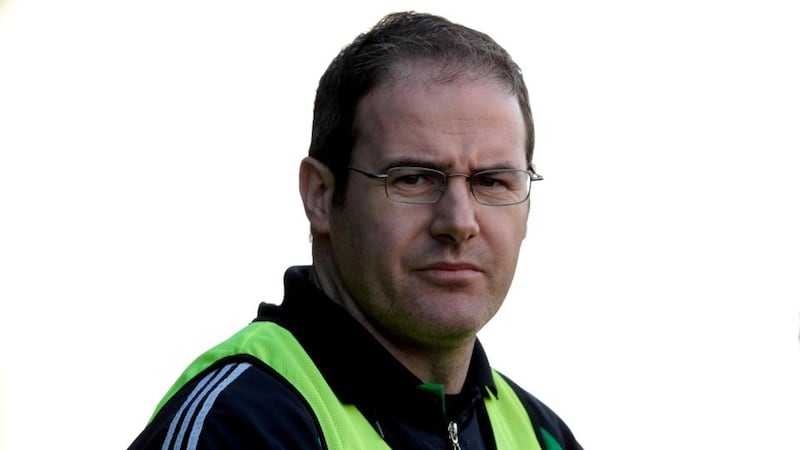There has been an understandable focus on the difference between Kerry this season and last. The county isn’t really interested in the role of luck in this year’s improvement. A year ago, if David Clifford isn’t injured before extra-time, do Tyrone still win by a point?
It’s hard to stand up that argument and if not, then in all likelihood Peter Keane is still manager and Kerry are All-Ireland champions.
Of course county boards don’t generally deal in counter-factuals. With a proven All-Ireland winner on board in Jack O’Connor, assisted by one of the most influential coaches of the century, Tyrone native Paddy Tally, Kerry have improved their defensive structure, which can be seen in the metric of one goal conceded in this championship, as opposed to seven last year over the same number of matches.
Read more
Ciarán Murphy: Family is family, but Galway football is my closest link to home
Kerry selector Mike Quirke credits players with making ‘sacrifice for success’
Cool-hand Kelly the ideal on-pitch expression of Joyce’s leadership of Galway
There is more to it than that. According to Maurice Horan, who this year was Billy Lee’s coach with the Limerick footballers, Kerry’s opponents in the Munster final, the strategy appears to be to encourage opponents into the 45 but exert pressure on the resulting attacks.
“For the last three games, they’ve let Dublin in 50 times, Mayo 49 times and Limerick 39 times. We got eight, Mayo got 13 and Dublin 16 (1-13). I would say that the fact you’re getting into their 45 relatively easily is almost like a trap they’re setting for you.
“The reason they’re doing that is that they break hard out of their own defence. That’s their strength. Letting you get up the pitch, almost taking you out of shape, stretching you as a team and then they’ve more space to exploit after you’ve pushed up into their 45.
“Another strength is their kick passing. They kick pass their way up into your 45 as opposed to Mayo and Dublin who run it in. The earlier the ball goes in, the more likely there is to be space. The opposition don’t have time to get back and set up in shape.”
That looks to be how it’s working. Poor conversion rates by the opposition – Mayo had 32 shots out of 49 attacks for 13 and Dublin 26 out of 50 for 16 – means that Kerry are doing something to disrupt opposition attacks whereas against Dublin they managed 35 incursions into the Dublin 45, 24 shots and 17 scores – not exceptional finishing by themselves but well ahead of the opposition.

Horan says that the Munster champions proactively shut off the route to goal, which has played a big role in suppressing the goals conceded.
“They’re protecting the channel into their goal and we know all about the fact that they’ve conceded fewer goals. I think they’re also protecting the full-forward area with that kind of tandem between Jason Foley and Tadhg Morley which has been very effective.”
It also appears that as well as blocking the direct approach, Kerry are flooding the area where the ball is, partly to disrupt opposition attacks but also to heighten the chances of dispossessing their opponents.
“They’re doing the scramble defence. Whatever side the ball is on, all the players collapse in, in that direction. The defensive benefit is that there is very little opportunity to run in a goal because you’ve to go through a swarm of bodies.
“Secondly if you create space for a shot there’s probably someone diving at your boot as you’re about to kick it. There are probably 12 players there, leaving out the goalie, Paul Geaney and David Clifford, which makes the pitch very small for the attacking team.
“It’s a split-second thing. Turn it over and it’s off they go to the races. You’re then in that desperate position where you’re trying to defend, running back to your own goal. You’re probably level with ball at best and you see Paudie Clifford firing an angled pass into the brother in a one-v-one.
“Remember that of the 50 Dublin attacks, there were 24 that didn’t result in shots, a lot of which presumably wound up as turnovers.
“They take energy from knowing that a turnover forced on the side where they have the overload will lead to a counterattack. It’s almost like defending half the 45. Draw a line from the far goalpost out to the 45, there will be very few Kerry players on the opposite side.
“Dublin did try to exploit it but by the time they get ball over – two kick passes, one outside the 45 because you’re not going to go through them and another angled kick to the receiver. Kerry back themselves to get across.”
For Horan Sunday is a dual test. Obviously Kerry are desperate for an All-Ireland but he also believes that if they have to battle against Galway that will suit the second agenda, which is to create another era of success for the county.
“Deep down they’ve been looking for this in the past few games and it’s what they will have taken from Dublin. The mood appears to be that if they could get over this and ideally, be tested and the harder the better there should be more than one All-Ireland for them.
“I’d be amazed if Jack O’Connor and his management aren’t seeing this as – definitely vital and necessary to win on Sunday – but also an opportunity for them to span a number of years.”















